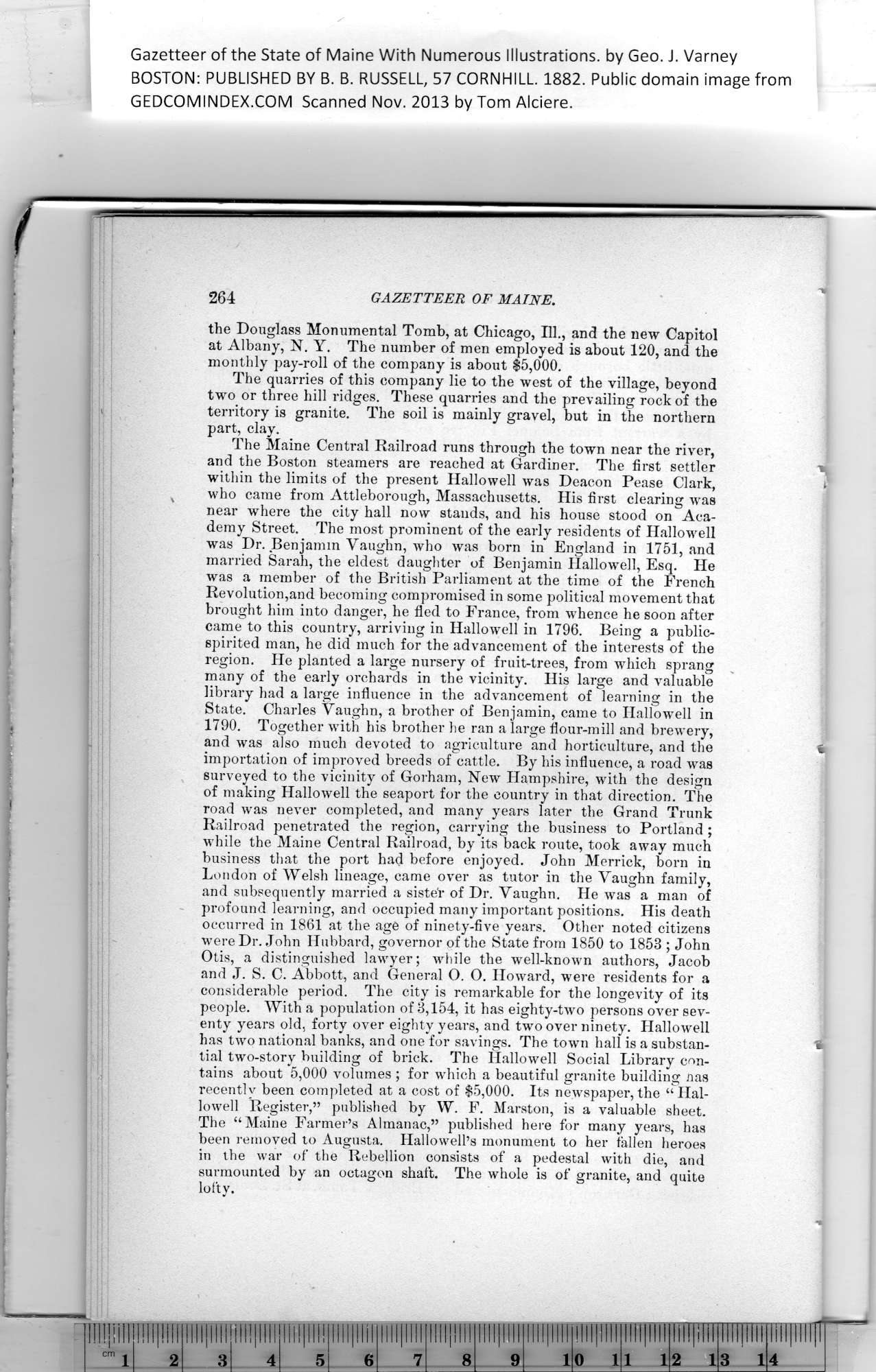|
Gazetteer of the State of Maine With Numerous Illustrations, by Geo. J. Varney
BOSTON: PUBLISHED BY B. B. RUSSELL, 57 CORNHILL. 1882. Public domain image from
264 GAZETTEER OF MAINE.
the Douglass Monumental Tomb, at Chicago, 111., and the new Capitol
at Albany, N. Y. The number of men employed is about 120, and the
monthly pay-roll of the company is about $5,000.
The quarries of this company lie to the west of the village, beyond
two or three hill ridges. These quarries and the prevailing rock of the
territory is granite. The soil is mainly gravel, but in the northern
part, clay.
The Maine Central Railroad runs through the town near the river,
and the Boston steamers are reached at Gardiner. The first settler
within the limits of the present Hallowell was Deacon Pease Clark,
who came from Attleborough, Massachusetts. His first clearing was
near where the city hall now stands, and his house stood on Aca-
demy Street. The most prominent of the early residents of Hallowell
was Dr. Benjamin Vaughn, who was born in England in 1751, and
married Sarah, the eldest daughter of Benjamin Hallowell, Esq. He
was a member of the British Parliament at the time of the French
Revolution,and becoming compromised in some political movement that
brought him into danger, he fled to France, from whence he soon after
came to this country, arriving in Hallowell in 1796. Being a public-
spirited man, he did much for the advancement of the interests of the
region. He planted a large nursery of fruit-trees, from which sprang
many of the early orchards in the vicinity. His large and valuable
library had a large influence in the advancement of learning in the
State. Charles Vaughn, a brother of Benjamin, came to Hallowell in
1790. Together with his brother he ran a large flour-mill and brewery,
and was also much devoted to agriculture and horticulture, and the
importation of improved breeds of cattle. By his influence, a road was
surveyed to the vicinity of Gorham, New Hampshire, with the design
of making Hallowell the seaport for the country in that direction. The
road was never completed, and many years later the Grand Trunk
Railroad penetrated the region, carrying the business to Portland ;
while the Maine Central Railroad, by its back route, took away much
business that the port had before enjoyed. John Merrick, born in
London of Welsh lineage, came over as tutor in the Vaughn family,
and subsequently married a sister of Dr. Vaughn. He was a man of
- profound learning, and occupied many important positions. His death
occurred in 1861 at the age of ninety-five years. Other noted citizens
were Dr. John Hubbard, governor of the State from 1850 to 1853 ; John
Otis, a distinguished lawyer; while the well-known authors, Jacob
and J. S. C. Abbott, and General O. O. Howard, were residents for a
considerable period. The city is remarkable for the longevity of its
people. With a population of 3,154, it has eighty-two persons over sev-
enty years old, forty over eighty years, and two over ninety. Hallowell
has two national banks, and one for savings. The town hall is a substan-
tial two-story building of brick. The Hallowell Social Library con-
tains about 5,000 volumes ; for which a beautiful granite building nas
recentlv been completed at a cost of $5,000. Its newspaper,the “Hal-
lowell Register,” published by W. F. Marston, is a valuable sheet.
The “Maine Farmer’s Almanac,” published here for many years, has
been removed to Augusta. Hallowell’s monument to her fallen heroes
in the war of the Rebellion consists of a pedestal with die, and
surmounted by an octagon shaft. The whole is of granite, and quite
lofty.
PREVIOUS PAGE ... NEXT PAGE
This page was written in HTML using a program written in Python 3.2
|
